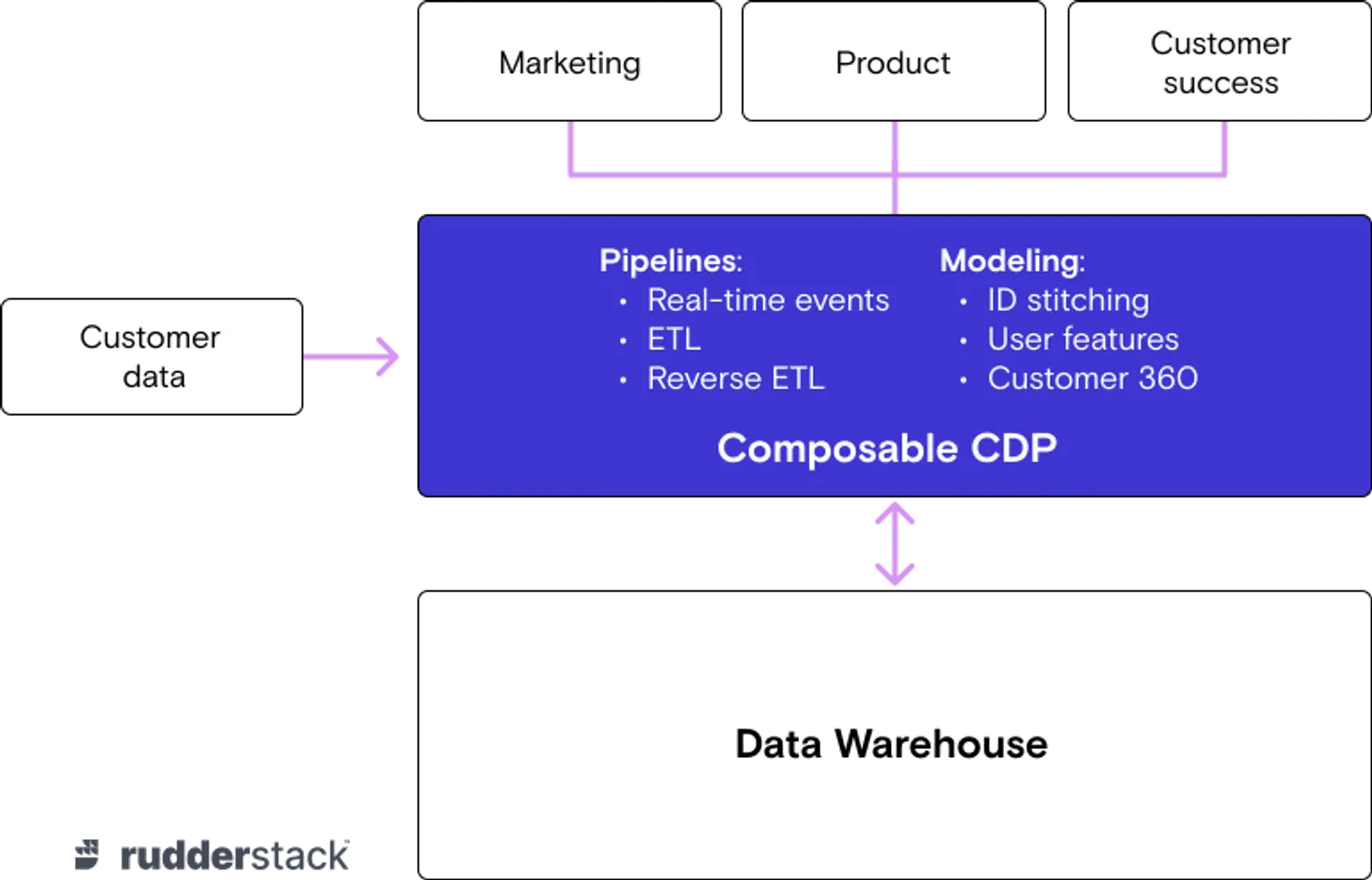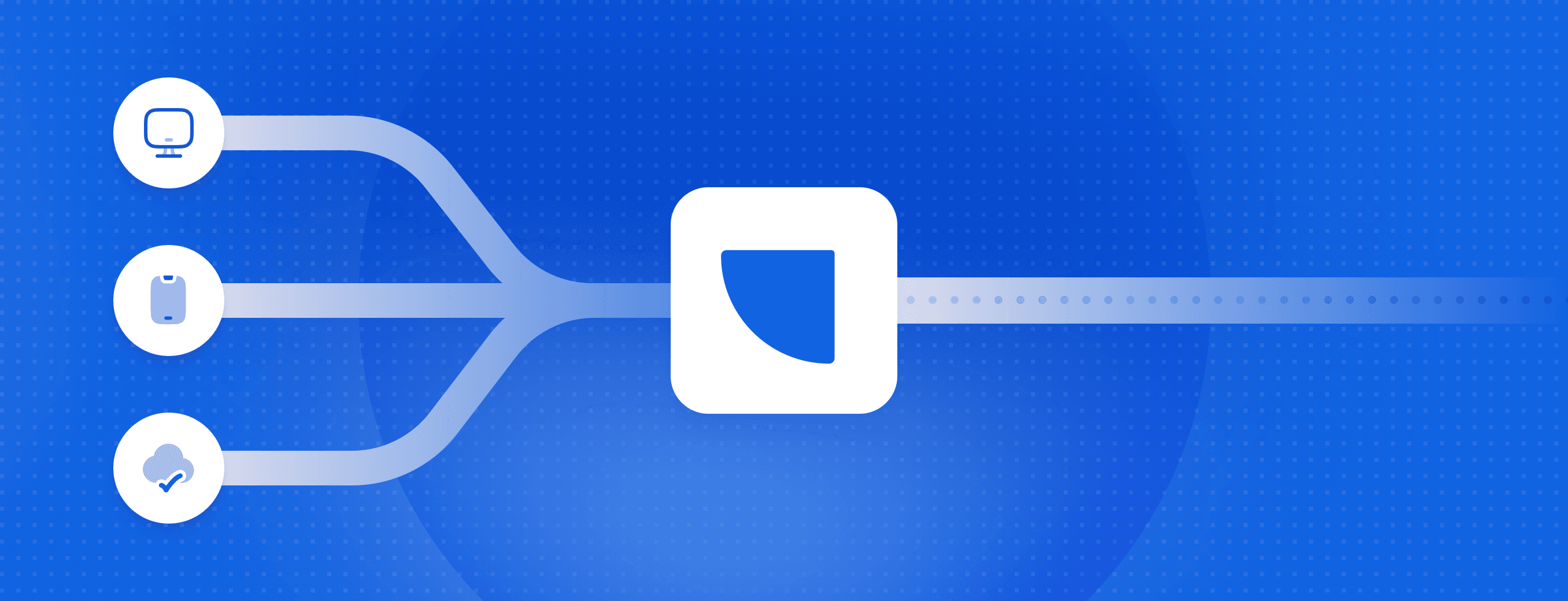What is a composable CDP? Demystifying the new approach to customer data

The composable CDP is being touted as the future of customer data management, but how exactly does it improve on previous systems?
Leveraging customer data is essential for modern businesses that want to stay competitive. However, professionals often express frustration about the limits of existing customer data platforms (CDP).
Many vendors offer single tools that promise to be the ultimate solution. However, these often fail to take into account that customer data use cases require a collaborative ecosystem that includes numerous tools and downstream teams.
By prioritizing flexibility and customization, composable CDP architecture offers a way forward. Read on to learn how to make your customer data work smarter with a composable CDP from RudderStack.
What is a composable CDP?
A composable customer data platform uses a modular approach to prioritize flexibility, adaptability, and customization in the management of customer data.
With a composable CDP, you can easily collect customer data from multiple sources, build customer 360 in your own data warehouse, and make data available to downstream tools. The primary function of the composable CDP is hydrating the warehouse and business tools with data—not serving as the data store or the data interface.
This modular approach enables businesses to create a tailored CDP solution that can easily evolve with their needs, providing seamless integration with various tools and platforms, and enabling efficient data management across diverse teams. By allowing organizations to build a custom, scalable solution, a composable CDP promotes agility and innovation while effectively addressing customer data use cases.
Composable CDPs allow organizations to mix and match components, services, and features to meet their unique requirements and create more personalized experiences. This solves the limitations of traditional CDPs, which we’ll explore next.
Understanding the history and limits of legacy customer data platforms
Customer data platforms emerged to address two significant challenges:
Challenge 1: Customer data ingestion at scale
Traditional marketing suites, such as Salesforce, Oracle, and Adobe, were not designed to accommodate different types of customer data on a large scale. This issue became particularly pressing with the rapid increase in first-party data sources and digital touchpoints –a dedicated data layer was necessary to gather and interpret this massive influx of information.
Challenge 2: Multi-channel customer experiences
Initial marketing tools were primarily developed for delivering digital experiences through a single channel, mainly email. However, the rise of digitalization demanded the ability to engage customers across multiple channels, including email, SMS, mobile, and advertising platforms.
Traditional CDP vendors attempted to solve these problems, but being both a data layer and cross-channel marketing platform is extremely hard. The technology itself is complex, but the bigger challenge is that the buyer and user personas for each component are very different. Ultimately, these legacy CDPs failed to solve either problem.
Traditional CDPs struggled with customer data ingestion at scale because they were designed for marketing teams and implementations rarely included adequate involvement from data and engineering teams. Developing a data layer capable of ingesting data at scale and ensuring its accuracy requires advanced APIs, SDKs, pipelines, monitoring, and governance. These complex technical requirements call for tools specifically tailored for data and engineering teams.
These tools even branded themselves as CDPs, reducing the need for standalone CDPs. But, these advanced marketing tools lacked robust data capabilities which prevented marketing teams from fully leveraging their potential. In the end, neither traditional CDPs nor these advanced marketing tools effectively addressed the core issue. If you ask marketing teams (or any other team) what their number one problem is, the answer almost always relates to data, regardless of the level of sophistication in the tooling they use.
Given these limitations, it’s no surprise that legacy customer data platforms continue to frustrate users.
How the composable CDP solves previous challenges
So, how does a composable platform address the challenges outlined above? Instead of attempting to be a single source of truth for customer data (Challenge 1) or competing with the UI/workflow/delivery layer (Challenge 2), a modern customer data platform needs to provide business teams with access to a comprehensive view of the customer.
The widespread adoption of cloud data warehouses as the foundation for creating a customer 360 (Challenge 1) paves the way for an elegant solution: a "composable customer data platform" architecture that functions as the linking element between customer data, the cloud data warehouse, and the rest of the stack.
There are three main ways that a composable CDP does this:
- Modularity: By providing organizations with a modular CDP architecture, there is no limit to the technologies and processes that can be used for data collection, storage, modeling, and activation. The ability to tailor customer data platform architecture to business goals improves customer data insights.
- Flexibility: Composable platforms are by nature more adaptable. By linking all customer data and providing access for all teams, any type of data can be leveraged for diverse use cases.
- Compatibility: A composable CDP is also technology agnostic, allowing it to be used with any other data warehouse or infrastructure platform. This future-proofs the data stack, allowing data teams to adapt to updates and future technology while avoiding vendor lock-in for the business.
Mastering composable customer data platform architecture
Composable platforms address the shortcomings of traditional CDPs and other business tools in several ways:
- Data teams can avoid building costly in-house data infrastructure or relying on limited marketing tools while maintaining full control over data management and access to the customer 360. This allows them to concentrate on delivering value through analytics and machine learning use cases, rather than managing pipelines or cleaning data.
- Marketing (and other business teams) can utilize their preferred tools (their front-end 'interface'), regardless of their integration with the warehouse or the composable CDP. With access to the full customer 360, they can maximize their tools' potential.
- No one is forced to use software that only addresses part of their needs or isn't designed with their specific team in mind.
This architecture establishes a separation of technological concerns in the tech stack among the various teams interacting with customer data. Data teams handle data ingestion into the warehouse or directly to APIs, run models (dbt/sql/yaml) to create the customer 360 in the warehouse, and expose the data to the business teams that require it (hydration). Business teams (marketing, product, customer relations, etc.) can focus on activating that data using their preferred tools and workflows.
A high-level diagram illustrating how the composable CDP architecture hydrates marketing tools and other business tools is presented below:

The advantage of this architecture lies in its flexibility as it does not require data teams or business teams to conform to a single, dominant integration pattern for utilizing the customer 360 across downstream systems.
Take marketing tools, for example, there are various patterns for using both real-time data and data generated in the warehouse. Since the composable CDP concentrates on collecting data and constructing the 360º customer view within the same warehouse, marketing teams can freely choose their preferred SaaS tool and connection type.
Here are a few specific examples:
- Tools like Salesforce and Braze are building direct integrations into the cloud data warehouse to pull data into their ecosystems. Over time, more vendors will develop these capabilities, making the composable CDP increasingly popular because with a composable CDP, teams can choose to leverage these native integrations while relying on their composable CDP for real-time data streaming when necessary.
- For tools that lack native connections to the warehouse or require first-party data sent directly to their APIs (typically for real-time use cases), the composable CDP is responsible for managing the connection and delivering or syncing data.
- Lastly, a new generation of tools, such as MessageGears and SuperGrain, operate natively on top of the data warehouse. Current reverse ETL vendors like Hightouch and Census are likely to develop competing capabilities. The composable CDP fully supports both patterns with the customer 360.
How businesses can benefit from a composable CDP
We’ve already explained that composable CDPs increase the flexibility, adaptability, and personalization of data management, but what does that actually mean for businesses? Let's look at some of the real-life benefits that using a composable platform can bring:
- Cost: When using a legacy CDP, you end up paying for a CDP on top of your data storage solution and other specialized tools. With a composable platform, you only pay for one catch-all solution. The future-proofing of a technology-agnostic solution will also save your business money in the long run.
- Data quality: A composable CDP handles all data types and works together with your other data solutions, making it incredibly easy to set up data monitoring and observability tools. With data alerting in place, the quality of your data will be the strongest it can be, improving data insights across your business.
- Efficiency: Traditional CDP platforms can take years to build and implement, while single tools can introduce the time-intensive issue of having to train teams on using new systems. Because a composable platform works with the tools your teams are already familiar with, it can be used at full capacity from day one.
- Creativity: A composable customer data platform makes all of your data easily available to the different teams across the business. This allows for increased collaboration and creativity when interpreting data insights.
- Security: Because legacy CDP architecture involves storing your data outside of your warehouse, it introduces significant security risks. With all of your data remaining inside your data infrastructure, composable platforms give you more control over data security and governance, preventing the chance of costly data breaches.
Composable CDP vs packaged CDP: How to choose which to use
If you’re searching for a customer data platform solution, you may well have come across the term packaged CDPs. Also known as a bundled CDP, this is another term for the traditional CDP system of a conventional, all-in-one solution that is ready to use out of the box.
In the early stages of composable customer data platforms, when they had to be built by a team of data engineers for every business, packaged CDPs had a faster time-to-value and were more cost-effective. However, the composable CDP has continued to evolve, and this is no longer the case. Furthermore, composable CDPs are not limited by the rigid architecture of a bundled solution. Flexibility is vital for handling complex data scenarios and also provides a more future-proof option. This means that a composable CDP is a better solution for any business that currently works with complex data infrastructure or is planning to in the future.
Future-proof your customer data management with a composable CDP from RudderStack
While existing data warehouses and data lakes (e.g. Snowflake, Amazon Redshift, and Databricks Delta Lake) are producing business tools that are better than ever at addressing the problems with legacy data management, composable CDP architecture provides a robust layer that solidifies the connection between the modern data and business stacks. With its warehouse-native architecture, RudderStack simplifies the collection, unification, and activation of customer data.
If you find yourself frustrated with legacy customer data platforms that silo your data and isolate your teams, join our data engineers, data scientists, and business professionals to experience how our warehouse native, composable CDP can bring your customer data management dreams to life.
Published:
August 20, 2024

Event streaming: What it is, how it works, and why you should use it
Event streaming allows businesses to efficiently collect and process large amounts of data in real time. It is a technique that captures and processes data as it is generated, enabling businesses to analyze data in real time

How Masterworks built a donor intelligence engine with RudderStack
Understanding donor behavior is critical to effective nonprofit fundraising. As digital channels transform how people give, organizations face the challenge of connecting online versus offline giving.

How long does it take you to see a customer event? If it's over five seconds, you're missing out
Access to real-time customer data is no longer a luxury. This article explains how a modern, modern, real-time infrastructure can help you close the gap between customer intent and action—before it’s too late.







